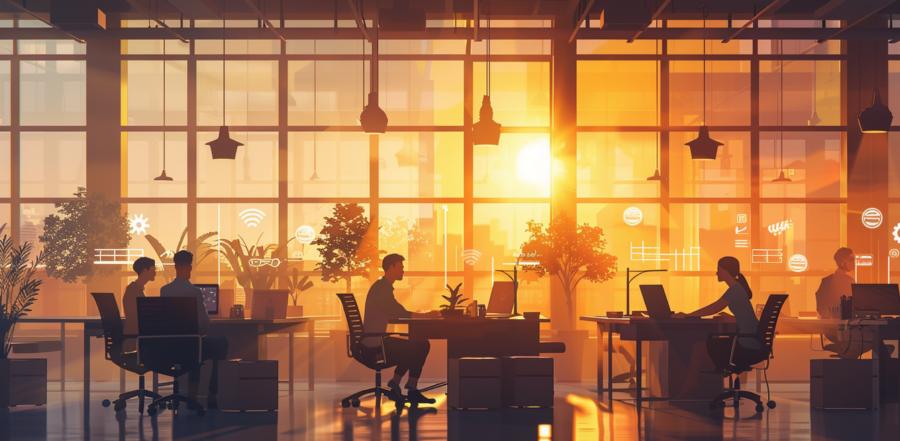When it comes to maximizing office productivity, natural light and thermal comfort aren’t luxuries; they’re fundamental design elements. And the science backing this isn’t fluff—it’s measurable, proven, and occasionally frustrating for architects still obsessed with form over function.
Natural Light Isn’t Just a Mood Booster
Here’s the deal: humans evolved under the sun, not under fluorescent tubes that hum like a nervous first date. Exposure to natural daylight helps regulate circadian rhythms, which in turn improves sleep quality, mood stability, and, crucially for employers, daytime alertness.A study by Northwestern University found that employees in offices with windows slept an average of 46 minutes more per night than their windowless counterparts. That’s nearly an hour of sleep purchased by glass and physics. More rest equals more focus, fewer mistakes, and—perhaps most importantly—less chance of someone falling asleep during your fourth Zoom call of the day.
But beyond sleep, there’s a direct cognitive payoff. Natural light has been linked to improved memory, faster reaction times, and higher performance in cognitive tasks. You want sharp thinking in the boardroom? Start by thinking about the room itself.
Where You Put the Window Matters
Window placement isn’t a game of architectural roulette. Orientation, height, and glazing all play critical roles. South-facing windows? Great in winter, but without proper shading, they can roast employees like rotisserie chickens by mid-July. East-facing windows offer crisp morning light but come with the risk of blinding desk workers as they attempt to read emails through squinted eyes.The real winners are designs that balance daylight distribution throughout the workspace. That means strategic placement to minimize glare, prevent screen reflections (because eye strain is not productivity’s friend), and make use of indirect light. Designers are increasingly turning to light shelves—horizontal surfaces that bounce daylight deeper into rooms—to get the benefits without the sunburn.
Thermal Comfort: Because Humans Are Not Reptiles
Too hot, and we melt into puddles of unproductivity. Too cold, and typing speed drops as fingers stiffen into claws. Thermal comfort is more than “not being uncomfortable.” It’s a zone—technically between 20°C and 24°C, with humidity hovering between 40% and 60%—where most people perform their best without noticing they’re performing at all.When buildings are poorly insulated, even the best HVAC systems are stuck playing whack-a-mole with temperature complaints. Good window insulation—double or triple glazing, low-E coatings, thermal breaks—helps keep internal temps stable, meaning fewer office-wide thermostat feuds (and fewer sticky notes threatening vengeance on whoever set it to Arctic Blast).
Add in window treatments like automated blinds or smart glass that tints based on sunlight intensity, and you’ve got a building that’s thinking about its occupants as much as its aesthetics.
Productivity Is an Environmental Issue
Let’s get blunt: if your office feels like a sauna or a dungeon, nobody’s getting their best work done. A 2017 study by the Harvard T.H. Chan School of Public Health found that workers in well-ventilated, properly lit, and thermally comfortable spaces had double the cognitive function scores of those in “typical” office settings. That’s not a mild bump. That’s the difference between “strategic planning” and “strategic yawning.”People work better when their environment isn’t actively fighting them. When thermal comfort and daylight are dialed in, meetings get sharper, creativity flows more easily, and employees don’t spend the day fantasizing about working from literally anywhere else.
Energy Efficiency Is the Silent Bonus
Now, for those who care about bottom lines and not just bright minds, here’s the kicker: well-designed windows also cut energy costs. By using daylight to reduce artificial lighting needs and keeping interior temps stable, a smart window setup can significantly decrease heating and cooling loads.It’s a rare win-win-win situation:
- Employees stay focused and healthy
- Utility bills get a little less smug
- Your building’s carbon footprint doesn’t look like a Godzilla track
More Glass, Less Sass
Let’s not pretend that simply adding bigger windows turns your open-plan war zone into a productivity utopia. It takes intelligent integration—balancing views with light levels, insulating without isolating, and knowing when to use tech to adapt the space throughout the day.The good news is, we’ve never had more tools. From thermochromic glass that darkens when the sun’s out, to real-time building monitoring systems that adjust ventilation and shading on the fly, the office of the future doesn’t just look brighter—it thinks brighter.
And when your workplace is lit just right, and the temperature isn’t trying to re-enact the surface of Mercury, you’ll find something surprising: people complain less, laugh more, and—miracle of miracles—actually get stuff done.
Clear Gains Through Clear Panes
It turns out that a window is more than just a rectangle in the wall—it’s a performance enhancer, a silent therapist, and a budget-friendly energy solution. With smart design and a little scientific backing, those panes of glass can do more than let in the view; they can let in focus, well-being, and meaningful results.You don’t need to bulldoze your building or commission an avant-garde architectural masterpiece to get it right. Just respect the science, stop fighting the sun, and maybe—just maybe—stop letting your office feel like a toaster. Because when the light is good and the climate’s right, people stop surviving the workday and start owning it.
Article kindly provided by conservationconstruction.com

